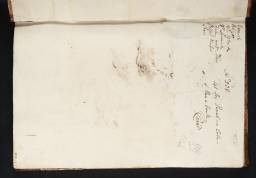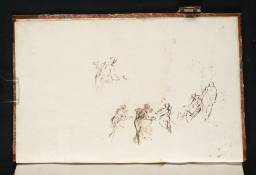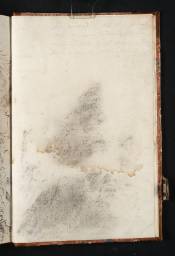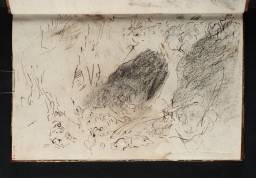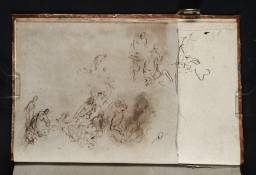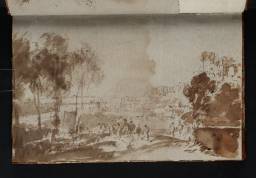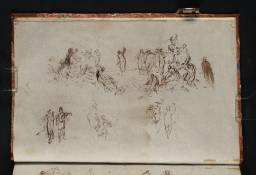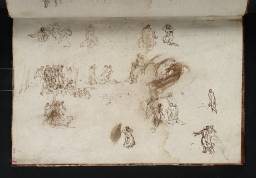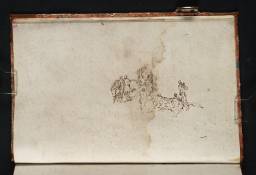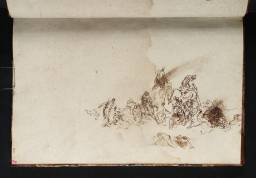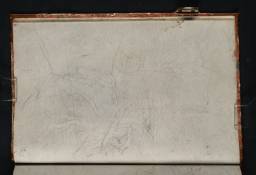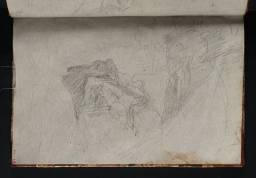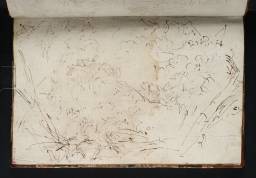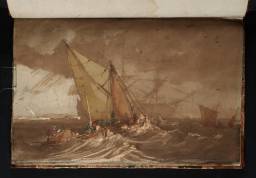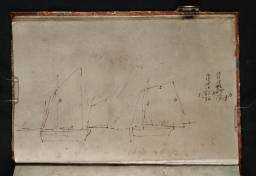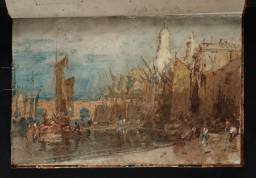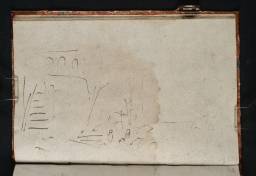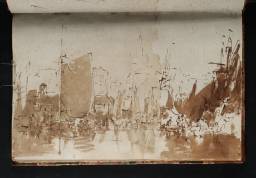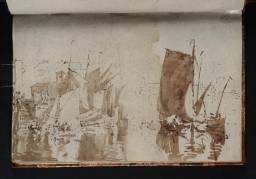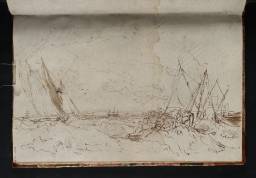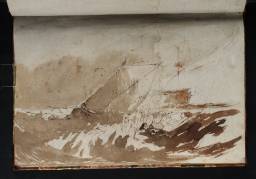Turner Bequest XCIII
Sketchbook, quarter-bound, in boards covered with blue and pink marbled paper, with leather spine and corners and two brass clasps
41 leaves of white wove writing paper made on a double-faced mould, prepared with a grey wash, and four flyleaves of white laid paper made on a single-faced mould
Approximate page size 171 x 262 mm
Most of the paper made by John Hayes and John Wise of Padsole Mill, Maidstone, Kent, and watermarked ‘HAYES & WISE | 1799’. The flyleaves from an unknown maker, without watermark
Inscribed by Turner in ink ‘71 H’ and in another hand in pencil ‘esperides Bk’on a label on the spine
Endorsed by the Executors of the Turner Bequest in ink ‘No 228 | 41 In Pencil in Colour | & Pen & Ink’ and signed by Charles Turner in ink ‘C Turner’ and in pencil by John Prescott Knight and Charles Lock Eastlake ‘JPK’ and ‘C.L.E’ on folio 1 (D05766)
A further endorsement by John Ruskin in recorded by Finberg: ‘228. Book of very great value. Pen sketches for compositions and marines. Compare 142, 282’. To this was added by Ralph Wornum ‘two coloured out. R.N.W.’
41 leaves of white wove writing paper made on a double-faced mould, prepared with a grey wash, and four flyleaves of white laid paper made on a single-faced mould
Approximate page size 171 x 262 mm
Most of the paper made by John Hayes and John Wise of Padsole Mill, Maidstone, Kent, and watermarked ‘HAYES & WISE | 1799’. The flyleaves from an unknown maker, without watermark
Inscribed by Turner in ink ‘71 H’ and in another hand in pencil ‘esperides Bk’on a label on the spine
Endorsed by the Executors of the Turner Bequest in ink ‘No 228 | 41 In Pencil in Colour | & Pen & Ink’ and signed by Charles Turner in ink ‘C Turner’ and in pencil by John Prescott Knight and Charles Lock Eastlake ‘JPK’ and ‘C.L.E’ on folio 1 (D05766)
A further endorsement by John Ruskin in recorded by Finberg: ‘228. Book of very great value. Pen sketches for compositions and marines. Compare 142, 282’. To this was added by Ralph Wornum ‘two coloured out. R.N.W.’
Accepted by the nation as part of the Turner Bequest 1856
Exhibition history
References
This sketchbook belongs to the group used along the Thames, mainly from circa 1805. It contains sketches and studies of the river and its landscape from Abingdon to the Estuary and the Nore, of rustic or working life and of classical and historical compositions. Early ideas for pictures to be found in the book suggest a date-range mainly between 1805–7.
Ruskin’s endorsement compared the sketchbook to the contemporary Studies for Pictures: Isleworth and Hesperides (2) sketchbooks (Tate D05491–D05617; D40568–D40574; D41505; Turner Bequest XC and Tate D0584–D5904; D40637; D41506; Turner Bequest XCIV). Turner’s label on the spine, ‘71 H’ (D40636), was amended by a later hand in pencil to ‘Hesperides’, a title retained by Finberg. Gerald Wilkinson considers ‘Hesperidean’ a ‘good description of the atmosphere of the sketches as a whole’ on account of their juxtaposition of the real and ideal.1 Simon Schama goes further, extending the name as if it were Turner’s own coinage to all the artist’s Thames drawings and watercolours, ‘among the very greatest wonders of his whole stupefying career’; ‘Turner knew what he was doing by calling the whole series Hesperides (meaning the world of the Happy Isles)’.2 This world, if such it was, was centred on Sion (or Syon) Ferry House, Isleworth, Turner’s out-of-town home from 1804–5 until 1806, which appears in its Thames-side setting on folio 26 verso (D05809). Anthony Bailey writes of its ‘Hesperidean garden’3 and the nearby wharf at Isleworth that served the river traffic. Here too was the mooring for Turner’s own boat for fishing and exploring the river, and the starting point for the excursions on which he took the book; folio 1 (D05766) has a list of items to take on such a tour, including pigments and his fishing rod. A fishing companion of Turner’s at this time was his old boyhood friend (and future Executor) Henry Scott Trimmer, now rector of Heston about half a mile from the Isleworth house. Trimmer was a classical scholar to whom Turner gave drawing lessons in return for instruction in Latin and Greek, and his company and conversation may have accounted for the preponderance of classical subjects in this and other sketchbooks used there.4
Sion Ferry House was also a place of work where Turner painted, reading and reviewed his impressions in his sketchbooks. The real origin of the name ‘Hesperides’ is the large number of early ideas for The Goddess of Discord Choosing the Apple of Contention in the Garden of the Hesperides exhibited in 1806 (Tate N00477);5 these are 1 verso, 3, 3 verso and 8–10 (D05767, D05770, D05771, D05779–D05783), and probably a further series of often rather slighter sketches, on folios 28 verso, 29 verso, 30, 31, 31 verso, 32 verso, 33 verso and 34 verso (D05813, D05815, D05816, D05818, D05819, D05821, D05823, D05825). In fact, examples like 3 and 30 show that Turner’s vision of the Hesperidean garden was more Alpine than English, based on memories of his tour of the mountains in 1802. But while neither as developed nor as closely aligned to real Thames scenery as the historical studies in the contemporary Studies for Pictures: Isleworth sketchbook, these and other drawings nevertheless show his imagination running on historical lines beside the Thames. Folio 4 (D05772) has early ideas for Mercury and Herse exhibited in 1811 (on the London art market in 2005)6 and folios 4 verso–7 (D05773–D05778) for Dido and Aeneas exhibited in 1814 (Tate N00494),7 including a composition study. A motif of a rearing horse with figures emerging from the Dido and Aeneas drawings seems to have been transferred to The Destruction of Sodom (Tate N00474).8 While this connection has not been observed before, Finberg, followed by Nicholson, identified several of the drawings broadly for The Goddess of Discord as representing Diana and Actaeon, and Turner may have thought of using the same background for different classical narratives.
Turner jotted a further historical reference, to the ‘fall of Rome’, inside the front cover of the book (D40632). It hints at the classical subjects to come, though none tackle this one. Turner owned a copy of Oliver Goldsmith’s Roman History and was attracted by the theme of the rise and fall of empires. Britain’s commercial empire was currently threatened by Napoleon’s Continental System, established in 1805 to blockade maritime trade. A splendid colour study on folio 12 (D05785), one of the most impressive in the book, shows the Pool of London crowded with shipping and might, as Hill suggests, be a design for ‘a modern equivalent of Claude’s great historical ports’ and thus perhaps for another of Turner’s didactic ancient/modern pairings. With other views of the Thames passing through the City it is evidence of a trip down-river that extended as far as Gravesend and Sheppey. Turner made sketches on the spot and worked some up afterwards in wash or watercolour including folio 16 (D05791) which served as a basis for Sheerness and the Isle of Sheppey, with the Junction of the Thames and the Medway from the Nore exhibited in 1807 (National Gallery of Art, Washington D.C.).9 The picture belongs to the group of Thames marines in which fishing boats, cutters or passenger hoys go about their business under the watchful eye of the Admiralty guardship protecting the naval base at the Nore. This reassuring formula is seen again in a wash study on pseudo folio 11 (D05838), which may have helped form another picture, The Confluence of the Thames and Medway exhibited in 1808 (Tate T03874, displayed at Petworth House).10 Andrew Kennedy has associated pictures like these with Turner’s trip to Sheerness at the turn of 1805–6 to see the Victory when she returned from the Battle of Trafalgar, and it may be that Turner had this sketchbook with him.
Sketches or studies for various other pictures occur in the book. Folio 21 verso (D05799) has two small variants of a composition of meadows, a boat and cattle related to Abingdon exhibited in 1806 or 1807 (Tate N00485);11 these were probably not drawn on the spot but in the studio. Folios 35 verso, 37 verso and 38 (D05827, D05831, D05832) have composition and other studies for Richmond Hill and Bridge exhibited in 1808 (Tate N00557).12 Folio 36 verso (D05829) is a composition study for The Thames near Windsor perhaps exhibited the previous year (Tate T03871, displayed at Petworth House).13 Sketches of figures and horses watering on folios 44, 44 verso and inside the back cover (D05842–D05844, D40635 were probably made on the spot somewhere by the river and are related to one of the series of contemporary, unfinished canvases of Thames and related scenery, Men with Horses Crossing a River (Tate N02695). 14 Folio 22 verso (D05801) has an interior with figures, similar in some respects to Country Blacksmith Disputing upon the Price of Iron, and the Price Charged to the Butcher for Shoeing his Poney exhibited in 1807 (Tate N00478)15 but perhaps of a kitchen rather than a smithy. Folio 23 (D05802) is another interior, usually described as rustic but possibly aboard a ship and made during Turner’s excursion down the Thames.
Further rustic figure groups on folios 23 verso, 24 verso and 25 verso (D05803, D05805, D05807) have attracted conflicting opinions, Finberg describing some of them as ‘carousing’ but Hill imagining that ‘we seem to be witnessing some kind of peasant revolt’. Turner’s typical unease with figures certainly allows for ambiguity, but the mood seems more comic-grotesque than distressed. Most probably these are harvesters, estate workers or at worst gleaners, and the sketches should join those associated with Turner’s unfinished pictures of harvest-time at Cassiobury Park, the Hertfordshire estate of the Earl of Essex which Turner visited in late summer 1807 (see Sketchbooks and Drawings Connected with Cassiobury Park and Harvest Pictures for the Earl of Essex circa 1807–12 and the oils Harvest Home (Tate N00562)16 and Cassiobury Park: Reaping (Tate N04663)).17 Related drawings are also in the contemporary Studies for Pictures: Isleworth sketchbook (Tate D05546, D05548; Turner Bequest XC 36a, 37a) so clearly ideas for this project intruded on his work along the Thames; moreover the Gothic north-west gateway at Cassiobury probably appears in 23 verso, along with a harvest wagon. Depicting outright rural misery would seem unlikely for a client such as Lord Essex and sit oddly with the patriotic reassurance that Turner drew from his Thames marines.
The most beautiful works in the book are a group of Thames watercolours towards the back as presently numbered – or the front if Turner began the sketchbook at that end (see below). These are not composition studies or studies for pictures, but independent and made on the spot. Their subjects were first identified by Edward Croft-Murray in marginal notes to a copy of Finberg now in Tate’s Library; more details on these and the rest of the book appear in Hill’s 1993 book. It must have been with the intention of making views like these out of doors that Turner gave the leaves a preliminary coat of grey wash so as to reduce the glare of the sun as he worked. In fact these watercolours, with their variable skies and occasional rainbows, recall the cool and changeable weather during the summer of 1805. Like Turner’s contemporary oil sketches they reveal the strong inclination to naturalism in his work at the time. He used one of them, the view of Kew Palace and Bridge on folio 38 verso (D05833), as the basis for a more finished watercolour (Whitworth Art Gallery, Manchester).18
The different functions of the drawings and watercolours in the book are mirrored in their styles and media. There are quick outline sketches, studies worked up with hatched shading and scratching out, wash or watercolour and others in pure watercolour. In Hill’s opinion, the contents fall into two distinct series, beginning from each end of the book and covering trips up-river from Isleworth as far as Abingdon and down-river to Sheerness. In his 1993 book, he sets out their ‘apparent chronological sequence’, beginning with folio 44 verso and reversing Ruskin’s and Finberg’s numbering (which he believes was applied in reverse throughout, considering ‘the way that a right-handed person would open the clasps’) as far as folio 19, before moving to the other end of the book and following their numbering in order from folio 1. Whatever the original order of execution, the present catalogue prefers to follow the original numbering in order to avoid complicated concordances. The presence of historical sketches in both Hill’s sections might, in any case, undermine a clear division.
James Hamilton, Turner’s Britain, exhibition catalogue, Birmingham Museums and Art Gallery, Birmingham 2003, pp.80–1; see also Hamilton, ‘Trimmer, the Revd Henry Scott’ in Oxford Companion, pp.343–4.
Technical notes
How to cite
David Blayney Brown, ‘Hesperides (1) Sketchbook c.1805–8’, sketchbook, August 2008, in David Blayney Brown (ed.), J.M.W. Turner: Sketchbooks, Drawings and Watercolours, Tate Research Publication, December 2012, https://www


